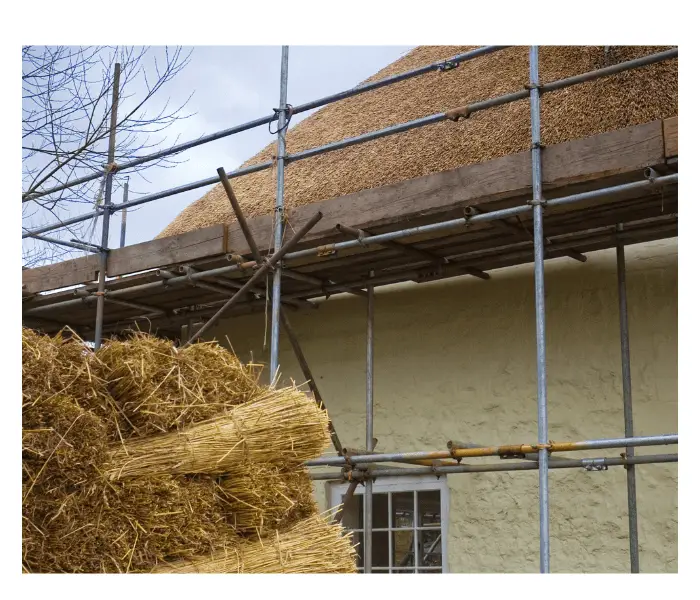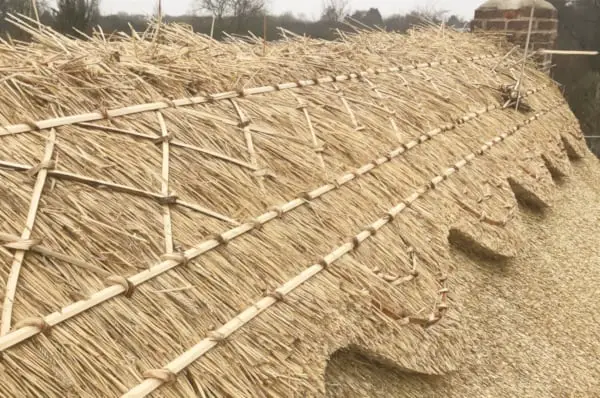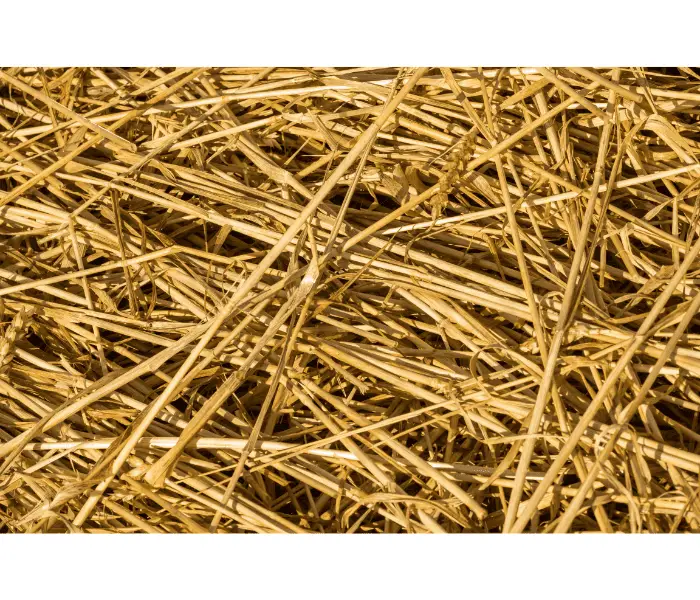Have you ever looked at a thatched roof and wondered what materials are used? If so, you might already know that the most common are water reed and straw.
But what you may not know is that not all straw is created equal, and that modern farming has had a big impact on thatching materials.
To explain why, let’s take a look at straw for thatching. By the end of this article, you should know all you need about thatching straw.

How Do You Grow a Thatching Straw?
The straw used for thatching is a by-product of cereal production. Cereals include oat, wheat, rye and barley, although wheat is the most common cereal used for thatching (as it’s also the most common for food production).
Thatching straw is grown like any other crop: in a field from seed. There isn’t much interesting to say about how thatching straw is grown because it’s a pretty standard process that hasn’t changed much for hundreds of years.
In the past, these crops were harvested manually using a scythe. Because of this, it didn’t really matter how long the stems were, and the leftover wheat was perfect for making thatched roofs.
However, modern industrial farming led to numerous changes in the way we grow crops, and what crops we actually grow.
Modern wheat varieties have far shorter stems that are suitable for harvesting with a combine harvester.
Old varieties grow much taller, meaning the harvesting process is less efficient and more input resources are wasted.
This has given rise to a comparatively modern term: long straw thatch.

Long Straw Thatch
Long straw thatch is straw specifically grown for thatched roofs. As mentioned, it needs to be longer than the stems of modern food varieties of wheat to make it a suitable roofing material.
Modern wheat varieties (any introduced after the 1950s) typically have stems around 75cm long. Older varieties, however, get much taller, meaning there’s more stem to work with when thatching.
For example, modern straw is suitable for 30cm thick thatch but won’t provide appropriate coverage for anything thicker. Long straw, on the other hand, can be used for pretty much any thatching setup.
Although it’s not a massive difference, much of the use of long straw also comes down to the preservation of traditional techniques.
Many thatchers prefer long straw to modern straw simply because it’s what’s always been used.
But as you can probably imagine, there’s not loads of demand for long straw. It’s more labour intensive to grow and thresh and doesn’t produce any usable wheat.
That said, there’s generally enough grown to satisfy thatchers who prefer to use long straw over water reed.
In fact, the seeds leftover from threshing are simply used as the following year’s crop. It’s interesting how thatching straw has gone from a by-product of wheat production to an actual produced crop in its own right.
How is Thatching Straw Harvested?
Luckily, thatching straw can still be harvested with machinery rather than doing it manually. Farmers use a cutting bar pulled by a tractor, combined with binder.
Unsurprisingly, the binder ties the stems together into sheaves.
The sheaves are then bundled together to make stooks. You might have seen these in wheat fields before – they’re the stacks stood up that allow the wheat to dry properly.
It’s done like this to ensure there’s enough airflow to prevent the wheat from rotting.
After drying and storage comes threshing. This is the process of removing the seeds from the stalks. In the past, it was done by hand using flails but now we have machinery to handle the whole process.
Once the wheat has been threshed, it’s pretty much the final material for thatching. The long straw is drawn together into a yealm, which are then bundled into a nitch.
From there, the nitches can be carried to the roof and used as a thatching material.

How Much Straw Do I Need to Thatch a Roof?
As you can imagine, there isn’t a single answer to how much straw is needed to thatch a roof.
The calculations aren’t particularly complicated, but there are numerous factors to consider when it comes to working out the amount of straw needed.
The first (and easiest) calculation is the roof’s area.
This is a simple one because it only requires the length and width, and is probably something we can all work out.
But then we need to think about the roof’s thickness, which is where it can start to get complicated.
The thickness dictates how much thatch is needed to appropriately cover the area, and it can add up to 1.5m to the overall calculations.
Finally, we need to factor in roof features, such as windows, chimneys, hipped ends, and more. Then there’s ridging to consider, too.
The bottom line is that every roof is different and working out how much straw is needed isn’t as simple as some basic geometry.
You could probably have a very rough idea by working out the roof’s area and then adding at least an extra metre onto your calculation. However, for an accurate figure, you’ll need to speak to an experienced thatcher.
How Long Does Straw Thatch Last?
Long straw thatch is a less durable material than water reed. Reeds are thicker and more water-resistant, meaning they take longer to degrade.
A straw thatch roof can last between 10 and 35 years depending on the roof area and material used. Long straw is less durable than combed wheat straw and has a general lifespan of 25 years.
However, the roof ridge needs replacing more often than this – usually between 10 and 15 years. This is because it takes most of the brunt of the weather, so it wears out faster.
You should expect to have a completely new thatched roof every 25 years or so if you’re using straw.
There are numerous factors that can shorten the lifespan of a straw thatched roof, including:
· Roof pitch (higher pitch means better water runoff)
· Quality of the thatch straw used
· General weather conditions
· The building’s location and aspect
· Proximity of trees to the roof
· Birds, rodents and other potential pests
· Experience of the thatcher
· Experience of other tradespeople working on or near the roof
· Environmental factors (pollution)
· The roof’s breathability
It probably comes as no surprise that water has a big impact on a thatched roof’s lifespan.
This is why factors such as breathability matter, as the roof should be able to expel humidity and moisture that seep up from the house below.
An experienced thatcher will generally be able to advise the best thatching material for the local weather conditions.
Once you’ve lived in a thatched property for a while, you should become familiar with the general signs of the roof ageing.
If you’ve only just moved in, it’ll be a good idea to call a thatcher out to give you a rough timeline of the roof’s next replacement.
Final Thoughts on Thatch Straw
Thatch straw is a popular material that maintains many of the craft’s traditions. While it’s not the most durable material, it’s used because of its history as a by-product of the food production industry.
So, next time you see a straw thatched roof, you’ll have plenty to say about this interesting material and how it’s used.


